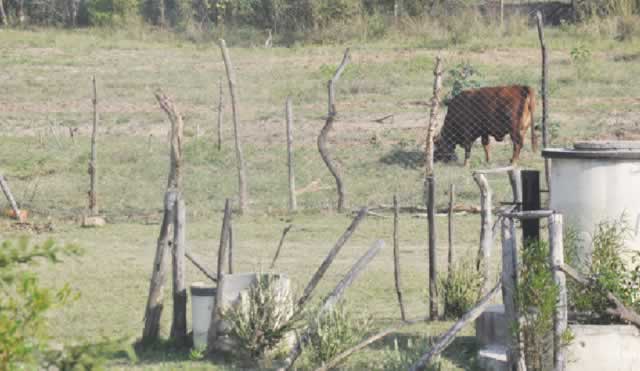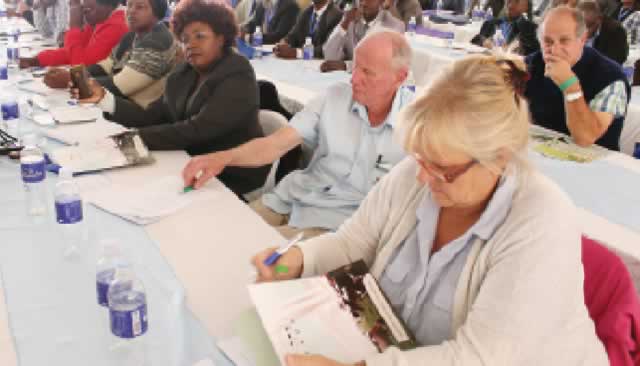Umzingwane nutritional gardens lose momentum

Ngqwele Dube
NUTRITIONAL gardens are one of the most widely used interventions across Third World countries to mitigate hunger and provide a vital lifeline for the vulnerable in many communities.
Small plots have become a source of food security for households that live in arid or semi-arid areas as people employ various water harvesting methods to tap into deep water sources to ensure water would be available to villagers throughout the year.
Non-governmental organisations in Zimbabwe have set up gardens for various communities particularly in drought-prone provinces and these have played a positive role in feeding families.
Being one of the arid provinces in the country which falls under Natural Region Five, Matabeleland South has its fair share of nutritional gardens with several NGOs descending on the region to assist people grow their own food all-year round.
Natural Region Five experiences low and erratic rainfall (less than 650mm per year) and is prone to drought year-after-year. It is most suited to ranching.
Among the NGOs that have assisted villagers set up gardens is Action Contra la Faim (ACF) which came up with a programme of setting up nutritional gardens in various areas including Umzingwane district in 2010.
While the noble actions of ACF were welcomed by all in the province, five years down the line questions are being asked about the viability of these gardens because three critical gardens in the area are now lying derelict.
As with all nutritional projects, a water harvesting system is critical to its sustainability and ACF decided to employ the elephant pump, which comes across as easy to operate and is not complicated allowing ease of maintenance. However, experiences of the villagers tell a different story.
The pumps built for the three gardens to provide water are in a state of disrepair and efforts to get them fixed have been unsuccessful.
The Chronicle visited the three projects, Josa, Thandanani and Lumene and found all of them in a sorry state.
Instead of teeming with crops, Josa and Lumene Gardens have become grazing areas for cattle as they have overgrown grass and shrubs while Thandanani has been neglected due to lack of water as all the pumps are not delivering the precious liquid for one reason or another.
According to pumpaid.org, the elephant pump, which was developed in Zimbabwe and awarded the St Andrews Medal for the Environment in 2005, is based on an ancient Chinese design that was in use over 2000 years ago. The design was greatly modified and improved by Ian Thorpe who adapted to make it stronger and more durable. It is made and maintained using materials that are locally available in remote rural Sub-Saharan African communities.
A villager who stays near Josa Garden and assists one of the beneficiaries in tending her part, said the well is only nine metres deep instead of the recommended 15 metres hence it dries up quickly.
Thembelihle Sibanda, 29, said those tasked with drilling the well came across a rock and decided against digging it further and there were no efforts to rectify the anomaly.
She said while people were eager to grow crops in the gardens the scarcity of water was a hindrance.
“Unless there is intervention from the authorities and they fix the problem for us, the gardens will become a haven for weeds. During the rainy season when the water table rises, we do get water from the pump but rains would be plenty at the time and most people would be focusing on their fields,” she said.
At Thandanani Gardens in Nqama Ward 10, Sithabile Nyoni, 19, a beneficiary of the scheme, said they are failing to raise funds to replace a rope that broke close to six months ago.
She said they had stopped all farming activities and were failing to raise money to buy the rope although two members of the scheme were trained in fixing the pump.
At Lumene Gardens, cattle breached part of the fence that has broken down and are grazing inside the garden.
Michael Ndlovu, 56, who stays next to the garden and is a beneficiary, said the breakdown of the pump was a blow to the community as it had provided water not only for the garden but also for home use.
They now depend on Lumene River for water.
Ndlovu said the pump broke down three years ago and they have been unable to fix it despite the fact that two members of the scheme had undergone training to repair the pumps. Efforts to get assistance from the District Development Fund have not yielded results.
Ndlovu said they had misgivings about the mechanism of the elephant pump from the start as it was new to them and felt it was more of an experiment when it was installed.
“The pump needs too much pulling power. Away from the community garden, I have my own fields and use a diesel-powered generator to draw water from Lumene River. Over the years I have managed to supply Bulawayo with tomatoes at close to 50 boxes a week from a hectare of land.
“The gardens only provided enough for household consumption and there was little surplus to sell off. Most people used to grow vegetables such as tomatoes, carrots, potatoes and beetroots,” he said, adding they now have to draw water from the stream for household use.
The beneficiaries said before the allocation of the gardens they used to work in their fields but they had limited harvests as they could only till during the rainy season and if there were no rains they would face starvation. The gardens enabled them to grow crops throughout the year.
The beneficiaries average between 17 to 20 people per garden. Each has seven beds that are half a metre wide and two metres in length in all the three projects.
The gardens are meant to provide food security with little or no surplus going on sale. Most beneficiaries are the elderly, impoverished and orphans.
An expert in agriculture and former DDF employee, Dumisani Mpofu, queried the setting up of such gardens saying there needed to be a fundamental paradigm shift that would see people being empowered to grow food for the market and earn money rather than just getting enough for household consumption.
He said the rationale behind the setting up of such gardens was myopic as it only focused on limited food production and failed to take into account the fact that villagers have other needs that include school fees, clothing and other household goods.
“Maybe government should be responsible for these projects because the NGO has left and in all their reports they will indicate it was a success. We need to learn from such schemes not to come up with piecemeal projects but we should seek to empower people holistically. Grouping villagers together is another big problem because they end up with small pieces of land that do not produce much but just enough for consumption.
“For any reliable agricultural project you need a water harvesting scheme that is viable. The installed system in those gardens is not very different from the laborious bucket system as people still need to carry the water to their gardens instead of providing pipes that reach the garden,” said Mpofu.
He said it was better to implement expensive methods that will bring positive results including income, rather than opt for cheap methods that fail in the long run.
“Again funding individuals is a lot better than focusing on groups and giving each person small pieces of land to till for food that won’t empower them financially.
“With proper monitoring mechanisms we could improve the projects such as providing pipes, tanks and the size of the gardens each person has in order to improve their efficiency,” Mpofu said.
“Such a mechanism should be a template that should be followed by all NGOs. We should change the way support is offered to communities because at the end of the day such piecemeal solutions do not have a lasting positive impact on the lives of villagers. Nutritional gardens are not effective in the current model they’re being made thus we need a change on this format.”
He said there were several individuals that have increased their agricultural output while using proper water harvesting technologies and this should be used as a basis for future programmes.
He cited a villager, Mthokozisi Ngulube, who despite not being involved in the community gardens has a thriving farming venture in his own fields.
An independent farmer in Ward 9, Ngulube, who uses a diesel-powered generator for irrigating two hectares of land, has been able to produce vegetables such as tomatoes, covo, garlic, butternut and onions for sale in Bulawayo.
“In good times I harvest 600 bundles per week which are sold to the market at a price of $2 a bunch over a period of between two to three months. What I earn from my field caters for my family’s needs ranging from food, personal items, school fees and leaves me with extra to plan for the next season.
“There is little rainfall in the area but I’m lucky, there is a stream near my homestead from which I get water from throughout the year,” said Ngulube.
Acting district agricultural extension officer, Thelani Ncube, admitted grouping people together for such projects was problematic but they appreciated the efforts of NGOs in initiating such gardens. He said it was up to the villagers to ensure they sustain them.
Ncube said cooperation among a group was difficult particularly when it came to an issue that needs money while an individual is more likely succeed in such ventures.
“World Vision had embarked on a poultry project in Tshalimbe Ward 8 and had set up a revolving fund whereby farmers were financed with initial capital and were given assistance in the initial period of the project while being hand held in managing the projects and this has been a success with few failures,” said Ncube.
He said there were a myriad of factors that affected the success of the gardens including the donor syndrome that seems to have afflicted villagers.
But the elephant pump had its own problems, with power being one of them.
Caritas Zimbabwe, an NGO also involved in developmental projects, has opted for submersible solar pumps after realising the weakness in the elephant pump. The NGO initiated Therelina Gardens in 2014 in Umzingwane. Welcome Sibanda, a development coordinator with the Catholic NGO, said they had initially employed the elephant pump but found that its maintenance was challenging.
“The technology of the (elephant) pump seems to be hard to maintain for the villagers and it also did not go very deep while users complained that it needs too much power when drawing water.
“Umzingwane is situated in a very arid area hence water sources are few and for us to succeed in our irrigation we realised we would need to draw water from deep sources as surface water is difficult to find and we decided to employ the sand abstraction method using solar power.
“Although more expensive, in the long run it is beneficial to the communities and we have managed to install pipes running into the gardens where there are tanks that store water. This makes it easier for elderly beneficiaries as they do not have to carry water for long distances. We’re experiencing more success at Therelina Gardens than at our previous projects where we used the elephant pump,” he said.
Sibanda said with water guaranteed throughout the year, the beneficiaries should be able to sell surplus crops with some of the funds generated being pooled into a fund that would be used repair the water harvesting system when it breaks down.
DDF acting district coordinator, Nkosana Ndlovu, said the submersible solar pumps were easy to maintain and invertors would only need to be replaced after five years if they are kept in good condition.








Comments